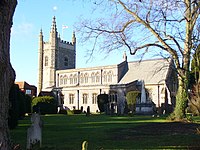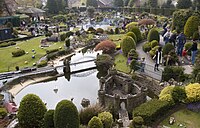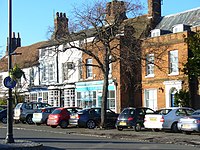Beaconsfield
| Beaconsfield | |
| Buckinghamshire | |
|---|---|
Aylesbury End, Beaconsfield | |
| Location | |
| Grid reference: | SU945900 |
| Location: | 51°36’3"N, -0°38’5"W |
| Data | |
| Population: | 10,679 (2001) |
| Post town: | Beaconsfield |
| Postcode: | HP9 |
| Dialling code: | 01494 |
| Local Government | |
| Council: | Buckinghamshire |
| Parliamentary constituency: |
Beaconsfield |
Beaconsfield is a fine and prosperous market town in Buckinghamshire. It is a town of two centres; the historic heart on the old London road and the New Town built around the railway station.
Old Beaconsfield is at the cross-roads around which is the delightful, green old town with its large parish church, the White Hart Inn and other hostelries and the broad street of London End. The crossroads is now a roundabout, which splits two roads into four names; the London to Oxford road is called here Wycombe End and London End either side of the roundabout (and by bureaucrats called the A40). The road to north and south is Aylesbury End (leading to the New Town) and Windsor End heading south. Old Beaconsfield has a number of old coaching inns along a wide street of red brick houses and small shops. It was the first (coach) stopping point on the road between London and Oxford.
South of the old town beyond the church and the little shops of Amersham End, the lane disappears into countryside, but is curbed off its natural route toward Farnham Royal by the interposition of the M40 motorway.
The New Town stands to the north, grown large around the station here and it is the retail and commercial centre along Station Road - Penn Road. It is not unpleasant and is the practical end of town. New Beaconsfield is also where the town has recentred itself residentially, along many streets fanning out from here. The Bekonscot Model Village is at New Beaconsfield.
Beaconsfield is found 17 miles southeast of the county town, Aylesbury. Other nearby Buckinghamshire towns include Amersham to the north and High Wycombe to the west. It is in the Chiltern Hills "Area of Outstanding Natural Beauty" and is part of the London commuter belt, thus the average cost of housing in the town is very high. The railway comes to the New Town, while the M40 runs just south of the Old Town, without impinging on it at all.
Parish church

The parish church at the crossroads of Old Beaconsfield is dedicated to St Mary and All Saints. It was rebuilt of flint and bath stone in 1869. It contains numerous memorials, old and new, and a chair given in memory of Benjamin Disraeli, Lord Beaconsfield (which peculiar construction is thankfully hidden away behind things).
The United Reformed Church in Beaconsfield can trace its roots of non-conformist worship in the town back to 1704.[1]
Name
The first written reference to Beaconsfield is found not until 1185, in which its name is spelled Bekenesfeld. The name is often assumedm understandably, to mean "field by the beacon," but the origin of the name is in "Beeches' field" (the Old English for which is Becena feld) perhaps from a clearing amongst the beech trees which even today dominate woodlands all about the town.
History and description
The parish comprises Beaconsfield town and land mainly given over arable land though some beech forest remains from that planted to supply the furniture industry of High Wycombe.
An annual fair is traditionally held on 10 May. Its charter, dating from 1269, originally allowed for a yearly market for the trading of goods and livestock, but it has now developed into a funfair, erected for one day only on the main roads of the Old Town. In recent years some residents have opposed the fair as a hindrance to the Old Town, and have called for it to be scrapped even though the fair has been going for over 735 years.
The Waller family originated at Groombridge Place in Kent, and later lived at Coleshill to the north of Beaconsfield, from the 14th century. In 1624, the family acquired Wilton Manor and Hall Barn in Beaconsfield:[2] A branch of this family was seated later at Newport Pagnell in Buckinghamshire, whence they removed in the 17th century to Virginia, where they became prominent in early Virginia affairs.
In the Victorian era the town was the home constituency of Benjamin Disraeli, Prime Minister of the United Kingdom in 1868 and then again from 1874 until 1880. His home, Hughenden Manor, is outside the nearby town of High Wycombe. In 1876 Disraeli was made the 1st Earl of Beaconsfield by Queen Victoria with whom he was in great favour. It was from Disraeli that Beaconsfield became a popular road name in industrial cities across the country in the late Victorian era.
The New Town
The New Town was a mile to the north of the original Beaconsfield when the railway arrived, at the opening of the 20th century. The station is on the Chiltern Main Line out of Marylebone towards High Wycombe it then branches to Aylesbury, and Birmingham Snow Hill. Old Beaconsfield which grew up on the Oxford Road in part to serve the coach traffic, is mirrored by New Beaconsfield which has grown up round the station.
Beaconsfield was named 'Britain's richest town' by The Telegraph in 2008. The ranking was based on average house prices, calculated to be £684,474 in Beaconsfield. The neighbouring towns of Gerrards Cross and Chalfont St Peter were listed as second.[3]
Bekonscot

Bekonscot is a model village created in the 1920s and 1930s; the first model village in the world. It covers 2 acres and is a popular day out for children.
The village portrays aspects of Britain mostly dating from the 1930s. Bekonscot has been run by the Church Army since 1978 and donates large amounts of money to charity. It has raised the equivalent of almost £5,000,000 so far and has been visited by more than 14,000,000 visitors.
Bekonscot was first created in the 1920s by Roland Callingham (1881–1961), an accountant of the town. He developed the plan for his miniature empire as an addition to his large back garden, drawing in help from his staff: the gardener, cook, maid and chauffeur. Together they developed the model landscape portraying rural England at the time. The swimming pool became the first "sea" and the undulating rockeries were built up as hills. Bassett-Lowke, the large-scale model railway manufacturers, were commissioned to build an extensive Gauge 1 railway network for the project.[4] Callingham named the village 'Bekonscot' after Beaconsfield and Ascot where he previously lived.
Bekonscot was not conceived as a commercial visitor attraction but as a plaything to entertain Roland and his guests. It was only after 1930 that its existence became widely known, catching the imagination of the press and public alike. Frequent newsreels such as Pathé, international and national newspaper coverage ensured a steady stream of visitors, all of whom were invited to make a donation to the Railway Benevolent Institution.
Literature and popular culture

Beaconsfield is the burial place of the author G K Chesterton, Edmund Burke and the poet Edmund Waller, for whom a tall stone obelisk was erected over the tomb chest in St Mary and All Saints churchyard.[5]
The town is the birthplace of Terry Pratchett, author of the Discworld series of fantasy novels.
Film
Beaconsfield Film Studios was founded here and has since become the National Film and Television School, where many film directors and technicians have learned their craft.
- Brief Encounter has several scenes filmed in the town: Station Parade served as Milford High Street and Boots on Burke's Parade was where Alec runs into Laura[6].
- Thunderball the James Bond film used the exterior of the Royal Saracens Head Inn
- Hot Fuzz filmed the interior shots for the pub in the Royal Standard pub.
The New Town also features in two other postwar colour films, John & Julie and The Fast Lady. Many other parts of the town have been used in films due to the old film studio and nearby Pinewood Studios. More recently it has often been used as a filming location for the television murder mystery series, Midsomer Murders.
Big Society
- Chiltern Shakespeare Company annually holds amateur performances of Shakespeare plays
- Beaconsfield Theatre Group, now over 60 years old
- Beaconsfield Operatic Society that has just celebrated its centenary
- The Young Theatre, a company "run by young people for young people" and winners of the All British Festival of One Act Plays in 2004.
Sport
- Football: Beaconsfield SYCOB Football Club
- Rugby: Beaconsfield Rugby Club
Transport
The town is very well served by road and rail. The M40 runs very close to the town (Beaconsfield is M40 Junction 2) and is 4 lanes wide in either direction from the M40/M25 Junction to M40 Junction 3. The motorway leads to London towards the east and Oxford and Birmingham to west. At Junction 2 is Beaconsfield Services.
The A355 runs between to Amersham and Slough through Beaconsfield, although this has very heavy traffic in peak times. The A40 through the Old Town parallels the M40 from London to Oxford and for years was the main road between the two cities. With the building of the M40 in the 60s and 70s the road has been relieved, but it still gets heavily congested. The B474 connects Beaconsfield to Hazlemere.
Rail links generally run close to the motorway. Beaconsfield railway station sees services to Birmingham Snow Hill and Moor Street, and London Marylebone. Beaconsfield is also a popular park and ride station for commuters who drive towards the capital along the M40 and M4 corridors but who do not want to take their cars into London, with its congestion, congestion charge and parking problems.
Outside links
- Beaconsfield Cricket Club
- The Beaconsfield Society
- Beaconsfield United Reformed Church
- The Enid Blyton Society
- Visit Buckinghamshire
- Enid Blyton Room
- The Young Theatre (at Beaconsfield)
- Chiltern Shakespeare Company
- Beaconsfield Theatre Group
- Beaconsfield Operatic Society
References
- ↑ www.beaconsfield-urc.org History Pages
- ↑ [Beaconsfield in A History of the County of Buckingham (Victoria County History)
- ↑ "Britain's richest towns: 10 - 1". The Daily Telegraph (London). 19 April 2008. http://www.telegraph.co.uk/property/3361042/Britains-richest-towns-10-1.html.
- ↑ Bekonscot Light Railway website
- ↑ Information on Beaconsfield from GENUKI
- ↑ "Filming locations for Brief Encounter (1945)". IMDB.com. http://www.imdb.com/title/tt0037558/locations. Retrieved 3 June 2012.